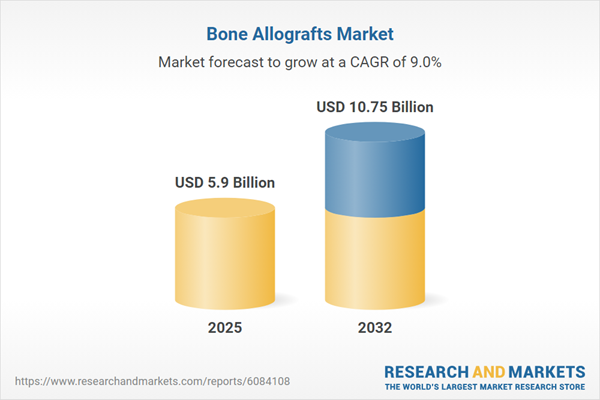Speak directly to the analyst to clarify any post sales queries you may have.
The bone allografts market is reshaping regenerative medicine and surgical care standards as healthcare providers, manufacturers, and regulators adapt to new technology and clinical demands. Senior business leaders require a clear understanding of sector dynamics to identify growth and innovation opportunities across this rapidly evolving landscape.
Market Snapshot: Bone Allografts Market Growth and Dynamics
The bone allografts market advanced from USD 5.41 billion in 2024 to USD 5.90 billion in 2025; it is forecast to reach USD 10.75 billion by 2032, achieving a CAGR of 8.95%. Growth is propelled by increasing adoption of advanced graft materials in varied surgical settings, and by the widespread implementation of sophisticated processing techniques. As regulatory expectations evolve, both healthcare providers and manufacturers are reassessing procurement and distribution strategies, emphasizing process optimization and supply resilience. The bone allografts market continues to expand its influence across multiple regions, driving new solutions for both complex and routine clinical procedures.
Scope & Segmentation: Strategic Overview
- Product Types: Cellular allografts, demineralized bone matrix (including powder, putty, and sheet formats), and structural allografts each address specific clinical scenarios. Cellular and demineralized options enhance precision in minimally invasive interventions, while structural variants provide the strength needed for major reconstructions.
- Applications: Use cases include dental restoration (ridge augmentation, sinus lift), joint reconstruction (hip, knee, shoulder), spinal fusion (cervical, lumbar), and trauma management such as fracture fixation and long bone repair, bringing targeted solutions to specialist surgical teams.
- End Users: Ambulatory surgical centers, hospitals, and specialty clinics form the primary customer base. Each group prioritizes rapid turnaround, robust clinical support, or procedural customization, depending on operational requirements.
- Source Materials: Allografts are sourced from cancellous, cortical, and corticocancellous bone, with each type providing a distinct balance of biological healing potential and mechanical support for different patient needs.
- Processing Modalities: Freeze-dried, fresh-frozen, and irradiated allograft technologies determine product shelf stability, biological activity, and distribution options, enabling alignment with diverse supply models and ensuring reliable clinical performance.
- Regions: The market covers the Americas (North America, Latin America), Europe, Middle East & Africa (across Western and Eastern Europe, Middle East, and Africa), and Asia-Pacific (extending to East, Southeast, South Asia, as well as Oceania), each region presenting unique growth drivers and adoption patterns.
Key Takeaways: Strategic Insights for Decision-Makers
- Development in demineralized and cellular allograft technology is enhancing possibilities for minimally invasive, targeted procedures, supporting surgeon-driven innovation and heightened patient outcomes.
- Collaborations among medical device companies, tissue banks, and research institutions are streamlining the introduction of next-generation allografts and improving market responsiveness to clinical needs.
- Digital enablement—via imaging and surgical planning solutions—is facilitating better preoperative planning, selection, and graft placement, leading to improved procedural accuracy and efficiency.
- Manufacturers emphasize operational efficiency through quality-controlled, user-ready formats that address expectations from clinicians seeking reliable, straightforward product integration.
- The Asia-Pacific region and other emerging markets experience increased adoption as healthcare investment and local processing capability expand. Established markets benefit from advanced reimbursement systems and premium product tiers, supporting continued clinical uptake.
Tariff Impact: Navigating the 2025 Regulatory Landscape
Recent U.S. tariff changes have adjusted supply chain dynamics and pricing models within the bone allografts market. In response, suppliers are transitioning to more robust sourcing approaches, prioritizing local partnerships and increasing visibility in their logistics networks. These measures support flexible inventory management and strengthen supplier relationships, enabling continued service delivery despite regulatory fluctuations.
Methodology & Data Sources
Findings are based on primary interviews with orthopedic surgeons, tissue bank executives, supply chain managers, and regulatory authorities, balanced by thorough review of regulatory documents, patent databases, published peer-reviewed studies, and clinical trial data. Credibility is reinforced through triangulation and independent validation to ensure reliability and relevance.
Why This Report Matters for Strategic Growth
- Highlights actionable market opportunities for innovation, efficient scaling, and clinical adoption across both growing and established regions.
- Provides essential insight on trends and regulatory frameworks, guiding decision-makers on effective strategies for entry, risk management, and sustained investment in the bone allografts market.
- Strengthens leadership ability to synchronize R&D, supply chain, and sales initiatives with market needs, supporting long-term resilience and growth.
Conclusion
The bone allografts market is driven by ongoing technology advancements, evolving clinical requirements, and regulatory changes. Stakeholders who leverage detailed market segmentation and adapt operations will be well positioned for future growth and sector leadership.
Table of Contents
3. Executive Summary
4. Market Overview
7. Cumulative Impact of Artificial Intelligence 2025
Companies Mentioned
The companies profiled in this Bone Allografts market report include:- Johnson & Johnson
- Medtronic plc
- Zimmer Biomet Holdings, Inc.
- Stryker Corporation
- B. Braun Melsungen AG
- Baxter International Inc.
- RTI Surgical Holdings, Inc.
- Musculoskeletal Transplant Foundation
- LifeNet Health, Inc.
- AlloSource
Table Information
| Report Attribute | Details |
|---|---|
| No. of Pages | 193 |
| Published | October 2025 |
| Forecast Period | 2025 - 2032 |
| Estimated Market Value ( USD | $ 5.9 Billion |
| Forecasted Market Value ( USD | $ 10.75 Billion |
| Compound Annual Growth Rate | 8.9% |
| Regions Covered | Global |
| No. of Companies Mentioned | 11 |









